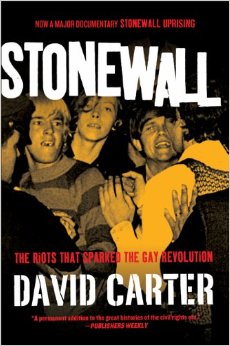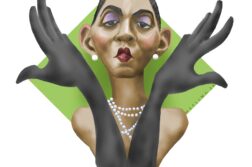 Stonewall: The Riots That Sparked the Gay Revolution
Stonewall: The Riots That Sparked the Gay Revolution
by David Carter
St. Martin’s Press. 352 pages. $24.95
THE STONEWALL RIOTS of June 28 to July 3, 1969, following a police raid on an illegal, Mafia-owned gay bar in New York’s Greenwich Village, marked a decisive turning point in gay American history. The unprecedented uprising has taken on mythic dimensions in the succeeding 35 years. Author and eyewitness Edmund White has compared Stonewall to the storming of the Bastille in 1789 Paris. Community lore has focused on the colorful aspects of the mêlée, like the wresting of a parking meter from a sidewalk for use as a battering ram against police, the funeral of Judy Garland, and the Rockette-style street theatre that participants used as a campy rebuke to the authorities. But due to a lack of narrative detail about the riots, Stonewall has become a metaphor for gay liberation while the events themselves are only vaguely understood.
Previous accounts of Stonewall in both the gay and mainstream press, including in Martin Duberman’s 1992 book Stonewall, have suffered for the incompleteness of the historical record. There is no film of the riots and only one “frontline” photograph from the critical night of June 28, 1969. Moreover, the Sheridan Square area of New York where the riot was centered afforded few vantage points from which crowd activity could be seen in overview. The insignificant press items from the time are biased and controverted in key particulars. Reconstruction would be impossible since the police lost the initiative soon after the raid, and there was no gay guerilla leader planning or orchestrating the assault from “our” side. Eyewitness accounts remain the primary source about the Stonewall Riots, though each is spotty when considered in isolation. Inferences culled from the context of time and place help fill out the picture.
David Carter’s new book, Stonewall: The Riots That Sparked the Gay Revolution, which he painstakingly researched over a ten-year period, has seemingly exhausted the storehouse of information about those climactic nights in 1969. Interviewing over forty eyewitnesses and carefully analyzing the times and milieus of Greenwich Village, where he lives, Carter has produced the first work that can be considered a comprehensive factual rendering of the Stonewall riots.
Stonewall settles a number of misconceptions that have grown up around the riots. First, the Stonewall Inn was not a bar frequented primarily by “drag queens” or full-fledged transgenders, though many customers did fit this description. The bar drew a cross-section of patrons from the homosexual population of the day. Unusual, perhaps, was the extent to which it welcomed younger and more marginal gays, including “street youth,” many of them homeless and living at large in the Village. There were lesbians among the clientele, both on the night of the riots and generally, but they were a small percentage. There were also sex-role conventional gays—a smaller group in those days—who turned to the Stonewall to escape their otherwise closeted existence.
Some confusion stems from the term “queen” as it was used in the gay argot of the day. The sizeable ranks of effeminate, but not transgender, young men were referred to as “flame queens” or “scare queens,” and may have worn makeup or an item or two of female clothing. Yet there’s no question that these were gay men, not transsexuals. They were among the most exposed elements of the gay population, because on the whole the young and effeminate were unable—or in some cases unwilling—to “pass” as straight.
Carter sheds considerable light on the question of who was most responsible for initiating the riots and carrying them out when they got underway. It is surely significant that a brawny, cross-dressing lesbian put up a mighty struggle against arrest. Her fierce resistance, widely observed, included two (ultimately unsuccessful) escapes from a police squad car, and she may have cried out for help. Her fighting example appears to have given rise to the hostile counterforce that swelled in Sheridan Square. (One eyewitness believes there was some “male chauvinist” outrage in the largely male crowd over a woman receiving such brutal treatment.)
But the drag queens had been the first element to offer resistance while still inside the club after the police raid. They were regarded as offenders under an arcane 19th-century law, and were subject to humiliating examination by policewomen to ascertain their genital identity. They refused to cooperate on the night of June 28th, causing the police to widen the scope of arrest to include cross-dressers—a move that took time. Several drag queens managed to escape the paddy wagon in which they were loaded for transport, to the crowd’s utter delight.
Carter singles out the street youths as most responsible for the conduct of the riots. The most effeminate gay men consistently demonstrated the greatest physical courage and daring. As the fearsome Tactical Police Force—the militarized riot police—were moving in on protestors, the queens camped it up like Rockettes and crooned a ditty that began, “We are the Stonewall Girls.” They broke up only as the batons came within range. Instead of dispersing, however, they repeatedly ran around the irregular blocks of Greenwich Village and confronted the disoriented riot police from behind. With skillful maneuvers on the streets they knew so well, the queens kept the riot police off balance for hours and significantly lengthened the time that gay demonstrators controlled the streets.
By the night of Wednesday, July 2, 1969, the riots had drawn in straight New Left and other radical types, astonished that a beleaguered group of gay men—held in general contempt at the time—had run circles around New York’s vaunted riot police. The resourcefulness and daring of the gay rioters set them apart from other protestors of the day, who invariably were bested when they went head-to-head with law enforcement. Straight radicals showed up in force on Wednesday, July 2, although once again it was the street queens who were the boldest in confronting the police and in taking their blows. Perceptions of gays were already undergoing some big changes.
Carter’s account is enriched by his inclusion of the police perspective of Inspector Seymour Pine, who was in charge of the raid. Pine, who authored the Army’s manual on hand-to-hand combat while serving in the Pacific during World War II, relates that he was never more afraid than when holed up in the club with his fellow officers as the rioters bore down from outside. Turf warfare within law enforcement helps explain why the raid happened despite the Mafia managers’ regular pay-offs to the local Sixth Precinct. In fact, friction among police units may have aided the arrestees, some of whom were able to escape custody.
The Stonewall Inn filled a unique niche in the gay scene of the time. Eyewitnesses stress the centrality of dancing to what went on at the club. Carter theorizes that unfettered same-sex dancing—a rarity at the time—created a unique social environment at the Stonewall and was its principal draw. Some observers saw a nascent tribal impulse incubating amid the lights, music, motion, and sensation—the group instinct that subsequently animated the collective assault on the police. Having operated since 1967, Stonewall was the largest gay bar in New York, possibly in the U.S. Its Mafia bosses seem to have been running an extortion ring out of the club, targeting the more well-to-do gays among its eclectic clientele. Its manager was implicated in an even wider blackmailing operation targeting wealthy gay men in places like hotel lobbies as far back as the 1940’s. Inspector Pine cites the club’s links to extortion, which had apparently reached into elite Wall Street firms, as a key reason for his wanting the bar shut down.
Carter delves into the question of whether Stonewall or something like it would have happened inevitably. Though he seems skeptical that it would, he eschews hard-and-fast answers. On the other hand, he’s clear in his belief that the riots set in motion an immediate transformation in the collective gay consciousness. Shocking as it was to everyone, gays simply stopped acquiescing in their own persecution and began demanding fair treatment and respect. The longer-term social consequences of Stonewall were mediated by the remarkable wave of community organizing that ensued in mid-1969. The activists who were empowered by the electricity of the riots were the ones to usher in concrete political advances. Carter speaks of the early movement, that of the Gay Liberation Front and the Gay Activists Alliance, as the “heroic age.” The pace of change was dazzling at the time, and appears remarkable 35 years later.
Carter largely avoids the more freewheeling assumptions that compromised Martin Duberman’s narrative. Even so, his dismissal of any connection between Judy Garland’s funeral on June 27th and the riots that same night seems peremptory. His claim is that the gay street youth who drove the riots were not of the generation that idolized Judy. Still, some eyewitnesses, such as Sylvia Rivera, spoke of the anguish they felt over the death of a star they had come to love as children. That loss could have entered into the sense of desperation that drove heretofore peaceful queens to violence. Carter overreaches when he writes Judy out of the script altogether.
One comes away from this book vividly impressed by the accomplishment of the Stonewall rioters and the activists who emerged in its wake. Carter has written what is likely to become the definitive history of this event in the struggle for GLBT liberation. Both scholarly and highly readable, the book deserves attention from all who have benefited from the historical events it so faithfully recounts.





